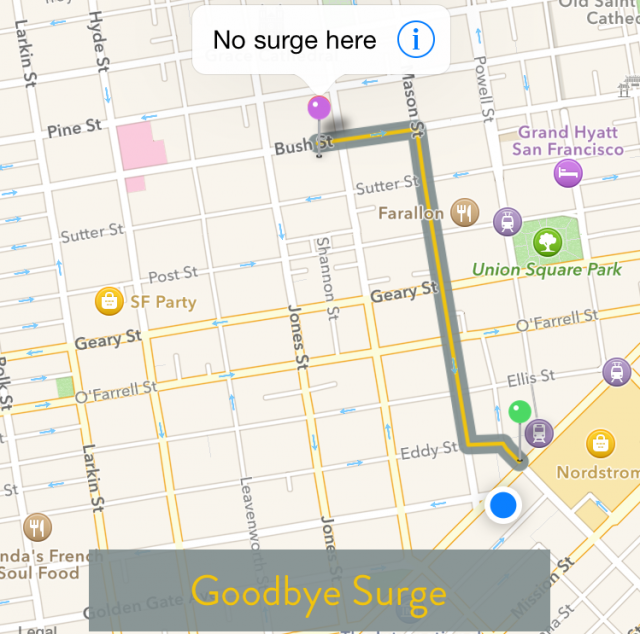How you (yes you!) can get around Uber’s surge pricing
New iOS app, SurgeProtector, shows users where to walk for lower Uber prices.
http://arstechnica.com/business/2014/11/how-you-yes-you-can-get-around-ubers-surge-pricing/

As Uber continues to expand worldwide (and has run-ins with local regulators), it’s become famous for its "surge pricing"—the phenomenon where as demand increases for cars, the price dramatically goes up.
To deal with this problem, enter a new, free iOS app (an Android version is coming soon) called SurgeProtector. The app aims to help Uber users avoid being shocked by surge pricing simply by telling them where they can go to pay more normal prices. (Uber did not immediately respond to Ars’ request for comment.)
The app, which was released last week, taps directly into the Uber API (which first became available in August 2014). It checks to see whether surge pricing is in effect for a given location.
"We have an algorithm that calls locations around you that tries to get a regular price—it’s surprisingly granular," Thomas Schmidt, one of the app’s creators, told Ars. "In places with high population density, it will be a difference of two to three blocks over, it can go from 2x surging to nothing. It’s super useful in San Francisco."
"During rush hour, Uber is more expensive"
Once the app finds the nearest location without surge pricing, it will then transfer the user over to the Uber app, inputting the non-surge location as a starting point. If nowhere within a one-kilometer radius of the user is surge-free, the app will find the lowest possible surge value—reducing what would have been a 3x surge to a 2x, for example.
In lower-density areas, such as suburban cities, surge pricing may affect the entire city, rather than just certain neighborhoods. That is, if a lower-density area reaches surge pricing at all.
"As far as how useful it is: anecdotally what I’ve seen is that in surge pricing, all of Palo Alto will have 1.5x. So unless you’re on the border [of the city], you’re probably not going to be able to get that surge down," Schmidt added.
So, essentially, the app is only really useful in an area that has a high demand for Uber cars. Some rush-hour attempts to use it in more residential areas of San Francisco, Oakland, and New York City on Monday evening showed no surge pricing. Though Daniel Stuckey, an Ars reader in New York, said that he wished he knew about the app the last time he used Uber "on a busy, rainy weekend night."
"My friend and I got hosed by a surge the other night, and not so wittingly," he told Ars by e-mail. "Turned out to be $65 for what in a yellow cab I know would be $26 tops."
Eventually, Kevin Ebaugh of San Francisco, another Ars reader, sent us the above screenshot of his attempt to use the app.
Interested users should grab the app and see for themselves however. Schmidt’s co-creator, Nikhil Bhargava, said that after less than a week, the pair doesn’t have any strong conclusions yet about where SurgeProtector will make the most impact.
"The generalizations are ones that most people are able to make already," he said. "During rush hour, Uber is more expensive. When the bar is closed, places that are filled with nightlife, the prices skyrocket."
No comments:
Post a Comment